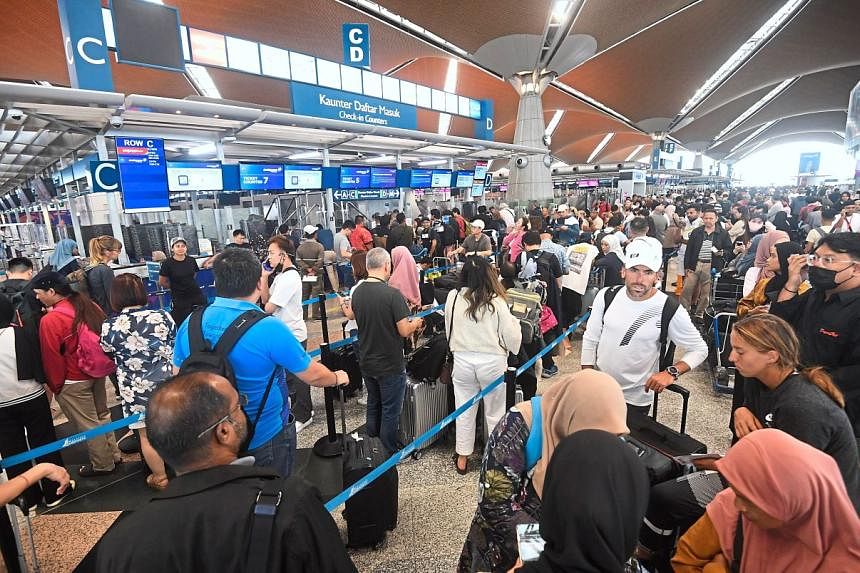PETALING JAYA – It could be weeks before flights between the peninsula and Sabah and Sarawak return to normal after a volcanic eruption left air traffic over the two states in chaos, said weather experts.
Much will depend on wind patterns and volcanic intensity due to the ongoing Mount Ruang volcanic eruption in north Sulawesi, Indonesia, and disruptions may last until mid-May, said climatologist Azizan Abu Samah.
He said it is crucial to monitor at what height and in which direction the volcanic ash is being transported by prevailing wind conditions.
“We are now in the inter-monsoon season and the air may not clear until May when the south-west monsoon sets in. The main issue is how the volcanic plume is transported by the wind. We do not want airplanes to fly into the plume which could cause damage to planes or malfunctions,” he said on April 18.
Thousands of air passengers in the two states were left stranded when Mount Ruang unleashed its fury in north Sulawesi on April 18, and airlines have been left awaiting the green light to resume service.
At press time that day, only AirAsia had announced that it had “reinstated” some flights involving the Bintulu, Kuching, Sibu, Kota Kinabalu, Johor Bahru and Kota Baru routes on April 18.
The low-cost carrier said in a statement that it had notified the affected passengers and advised them to check their e-mails and mobile phones for cancellation notifications.
Current weather satellite images, Dr Azizan said, show the presence of fine particulate matter that are 2.5 microns or less between 18,000ft and 33,000ft over Sabah.
“Most airlines tend to fly at between 18,000ft and 33,000ft and may be affected by the ash flow not only in northern Borneo but also in Kuching in Sarawak,” he said.
Dr Azizan noted that the intensity and duration of the volcanic eruption also play a role in deciding how long the disruption may last.
He cited the eruptions of Eyjafjallajokull in Iceland, which forced the cancellation of about 100,000 flights in several countries in northern Europe for more than a month between April 15 and May 17 in 2010.
Dr Azizan had previously suggested that Asean set up its own volcanic ash alert system since there are many volcanoes, especially in Indonesia and the Philippines.
“Such systems already exist in Europe and the United States,” he said.
According to the Civil Aviation Authority of Malaysia (CAAM), the volcanic ash clouds moving westerly observed within the Kota Kinabalu flight information region (FIR) will pose a significant risk to aircraft safety.
CAAM chief executive officer Norazman Mahmud said this had affected multiple air routes and airports in the region.
“The eruption prompted the issuance of Significant Meteorological Information (Sigmet) 1 by the Malaysian Meteorological Department at 6am, indicating the presence of ash clouds moving westerly at a speed of 30 knots from the surface to 55,000ft and intensifying.
“This has affected multiple air routes and airports in the region,” he said in a safety notice issued to airlines operators on April 18.
A sigmet is a weather advisory for pilots that alerts them to potentially hazardous weather conditions.
According to Datuk Norazman, airports within the affected area, including Tawau and Lahad Datu, should implement measures to mitigate the impact of volcanic ash on ground operations, such as regular monitoring of runway conditions and implementing appropriate cleaning procedures.
He said the volcanic ash clouds could cause severe damage to aircraft engines and aircraft systems, leading to potential engine failure, reduced visibility and damage to critical components.
“The volcanic ash can also interfere with aircraft avionics, posing a serious threat to flight safety. Therefore, aviation stakeholders must exercise extreme caution and implement appropriate measures to mitigate the risks associated with volcanic ash encounters,” he said.
He advised air operators to closely monitor meteorological updates, volcanic ash advisories and Notice to Airmen issued by relevant authorities.
“Pilots should exercise vigilance and adhere strictly to established procedures and guidelines for avoiding volcanic ash encounters, including diverting flight paths, emergency response plans, altering altitudes, and maintaining communication with air traffic control,” added Dr Norazman.
He said air traffic controllers are to maintain a constant watch on the development of ash clouds, and update routes and altitude clearances when necessary to maintain aviation safety.
“This includes providing timely and continuous updates to all affected aircraft about changes in the location of ash clouds, density and expected movements,” he said.
CAAM also advised air traffic controllers to coordinate with adjacent air traffic controllers’ units to manage reroutes effectively, ensuring seamless transitions for aircraft entering or exiting the affected flight region.
“This is in addition to being prepared to implement emergency procedures for aircraft experiencing difficulties due to ash, such as prioritising landings, allowing for flexible use of airspace and coordination of potential diversions,” he added.
Dr Norazman advised airline passengers to stay informed about flight status updates provided by airlines and to exercise patience and flexibility in their travel plans.
Meanwhile, Malaysian Meteorological Department (MetMalaysia) director-general Helmi Abdullah said air quality over Sabah and Sarawak has not been affected by the Mount Ruang eruption.
He said this was based on observations of the pollution index on surface air in Sabah and Sarawak.
As at 5pm on April 18, 16 stations in Sabah and Sarawak showed healthy readings of below 50 points on the Air Pollutant Index, with only five having moderate level of below 100 point.
Mr Helmi said Indonesian authorities had raised the volcanic eruption warning to Level 4 (caution) and expected continued volcanic activity with further eruptions from time to time.
He added that the public could keep tabs on information issued by MetMalaysia through its official website, the myCuaca application and on social media. THE STAR/ASIA NEWS NETWORK

